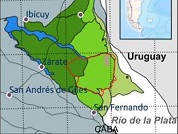Characterization of the vegetation in sites with evidence of anthropization in the Paraná River Frontal Delta
DOI:
https://doi.org/10.14522/darwiniana.2022.102.1041Keywords:
After abandonment vegetal communities, Delta del Parana Biosphere Reserve, flora, forest, marshes, riparian forestation, wetlandsAbstract
Anthropization is one of the main structuring factors of plant communities at a global scale. In particular, in the Paraná River Frontal Delta there was a strong process of settlement and transformation of the territory by productive activities during the 20th century with a process of depopulation and partial abandonment of the productive plots in recent decades. The original vegetation of the Frontal Delta was made up of flooding grasslands (“Pajonales”), open woodlands (“Ceibales”) and closed riparian forest (“Montes Blancos”), replaced in large areas by crops that after their abandonment gave rise to a secondary succession process. In this work we aimed to characterize the flora and plant communities in plots with evidence of current or past anthropization in the Frontal Delta. A total of 202 sampling plots of 25 m2 were established in which the species of vascular plants were recorded and their coverage was estimated. Taken together, 167 taxa were recorded of which 81% were native. Through multivariate analysis, 15 communities with different physiognomy and degree of invasion were identified and characterized. Some of these presented a great similarity with the original communities of the region, others were similar to secondary communities described in the bibliography and novel situations were identified. The results highlight the great local richness of the vegetation and the great diversity of plant communities, highlighting the importance of the study area for conservation.

Downloads
Published
How to Cite
Issue
Section
License

Starting on 2012, Darwiniana Nueva Serie uses Licencia Creative Commons Atribución-NoComercial 2.5 Argentina .





